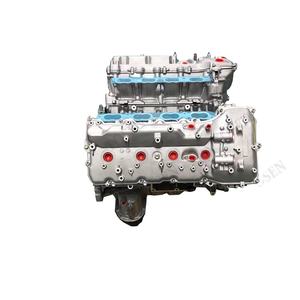Economical Opel Corsa Engine Options for Your Budget plan
Wiki Article
Discovering the Inner Functions of a Compact Car's Engine System
As drivers, we often consider given the intricate procedures that happen within the confines of our lorry's engine system. The small yet complex machinery that thrusts us ahead is a marvel of design precision and control. From the controlled surges in the combustion chamber to the meticulous timing of gas injection, every element plays an important role in the smooth procedure of the engine. In this exploration of a small vehicle's engine system, we will certainly unravel the internal workings of this mechanical harmony, shedding light on the secrets that drive us forward on our everyday trips.Combustion Refine Overview
The combustion procedure in a portable car's engine system is an important mechanism that successfully converts fuel right into power to power the vehicle. This process happens within the burning chamber of the engine, where gas and air mix, fire up, and create regulated surges. The burning process includes four primary phases: consumption, exhaust, compression, and power.Throughout the consumption phase, the piston moves downward, drawing in a blend of air and gas into the combustion chamber. This down activity creates the power required to drive the lorry. This cyclic combustion procedure is fundamental to the operation of a small automobile's engine system, making certain efficient energy conversion for propulsion.
Piston and Cylinder Interaction

The piston's accurate fit within the cylinder is vital for preserving ideal compression and stopping power loss throughout combustion. Tight clearances between the piston and cylinder wall surfaces ensure efficient securing, permitting the piston to relocate efficiently without permitting gases to leakage past. Appropriate lubrication is additionally vital to decrease rubbing and wear between these elements, boosting long life and efficiency.
Additionally, the style and materials made use of in making the piston and cylinder impact engine effectiveness and longevity. Modern engines frequently use lightweight yet long lasting materials like aluminum alloys for pistons and cylinder linings to lower inertia and boost thermal effectiveness. In general, the unified communication between the piston and cyndrical tube is fundamental to the engine's functionality and total efficiency.
Fuel Shot System Performance
Fuel shot systems in small vehicle engines play a critical role in specifically providing gas to the combustion chamber for controlled and effective ignition. The fuel shot system functions by infusing fuel right into the combustion chamber at the ideal moment during the engine's procedure (opel corsa engine). This exact timing ensures that the gas blends uniformly with the air for correct combustion, leading to boosted gas effectiveness and lowered dischargesThere are largely two kinds of fuel injection systems made use of in compact automobile engines: port gas injection (PFI) and straight gas injection (DFI) PFI systems inject gas into the intake port prior to the consumption valve, while DFI systems infuse gas directly into the burning chamber. Both systems have their benefits, with DFI providing much better gas atomization and PFI providing a much more cost-efficient service.
Comprehending Engine Air Conditioning Mechanisms
Effective procedure more of a portable vehicle's engine depends greatly on the performance of its cooling mechanisms. Engine cooling is check my blog necessary to protect against overheating, which can result in severe damages and lowered efficiency. The cooling system in a compact car normally includes numerous components interacting to control the engine temperature level. One critical component is the radiator, which uses coolant to absorb heat from the engine. As the hot coolant flows through the radiator, it releases heat into the air, cooling down before returning to the engine. The water pump circulates the coolant through the engine and radiator, guaranteeing a constant flow to regulate temperature. Additionally, the thermostat helps control the coolant circulation to keep optimum engine temperature level. Some automobiles likewise have cooling fans that activate when extra air conditioning is required, such as throughout heavy web traffic or hot weather. Recognizing these engine air conditioning systems is important for maintaining the performance and long life of a portable automobile's engine system.
Exhaust System Parts Explained
The ideal functioning of a small vehicle's engine air conditioning mechanisms depends on a corresponding system known as the exhaust system, which makes up numerous vital parts for guaranteeing reliable discharges and engine efficiency. The exhaust manifold collects exhaust gases from the engine's routes and cylinders them to the catalytic converter.One critical element of the exhaust system is the oxygen sensing unit, which monitors the oxygen degrees in the exhaust gases to aid regulate gas intake and guarantee ideal engine efficiency. opel corsa engine. Additionally, the resonator may exist in some exhaust systems to reduce noise degrees. On the whole, the exhaust system plays a vital function in preserving engine performance, reducing dangerous exhausts, and ensuring a quieter driving experience for compact car proprietors

Conclusion
Finally, the compact automobile's engine system is a complex combination of parts that collaborate to help with the combustion process, convert fuel into power, and eliminate waste gases. Understanding the inner functions of the engine system, consisting of the piston and cyndrical tube communication, gas shot system, engine air conditioning mechanisms, and exhaust system components, is critical for maintaining optimal performance click and efficiency of the car.The combustion process in a small lorry's engine system is a crucial mechanism that effectively converts fuel into energy to power the vehicle.Fuel injection systems in portable vehicle engines play a critical role in precisely delivering gas to the burning chamber for regulated and effective ignition.There are mainly two types of fuel shot systems made use of in small automobile engines: port fuel injection (PFI) and straight gas shot (DFI) Comprehending these engine cooling mechanisms is essential for keeping the efficiency and durability of a compact vehicle's engine system.
The optimum performance of a compact vehicle's engine air conditioning devices depends on a complementary system known as the exhaust system, which consists of different vital components for ensuring reliable discharges and engine performance.
Report this wiki page